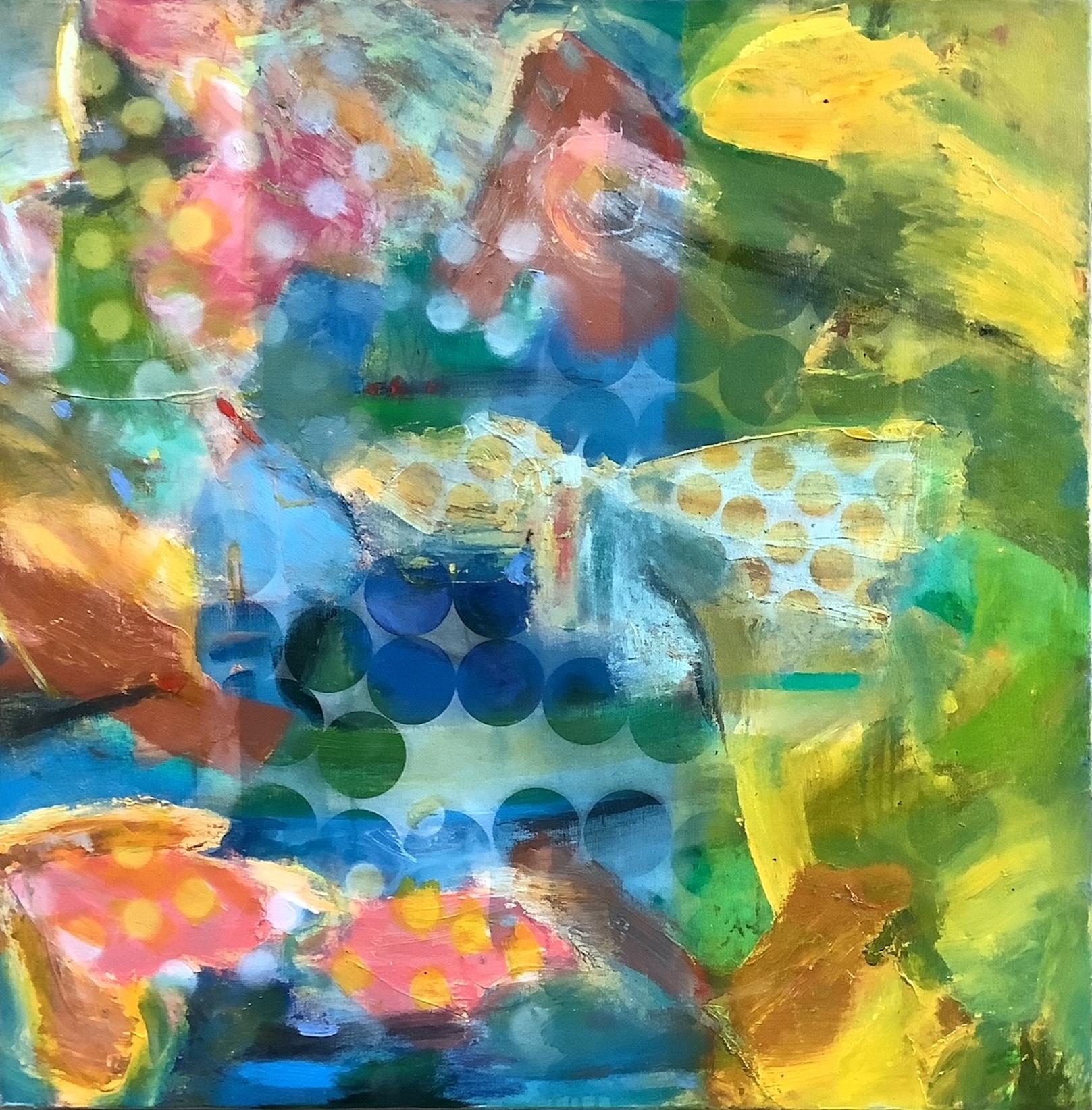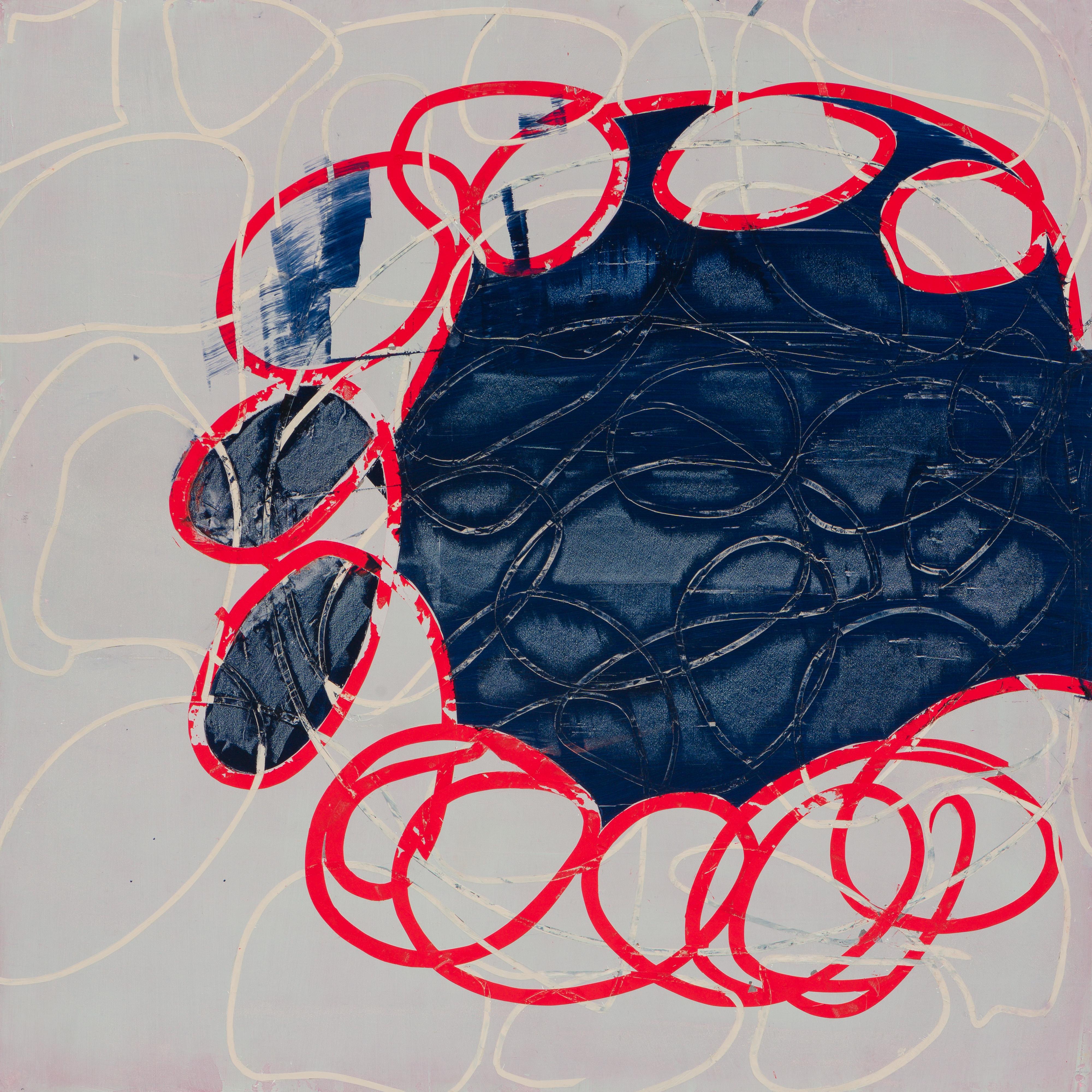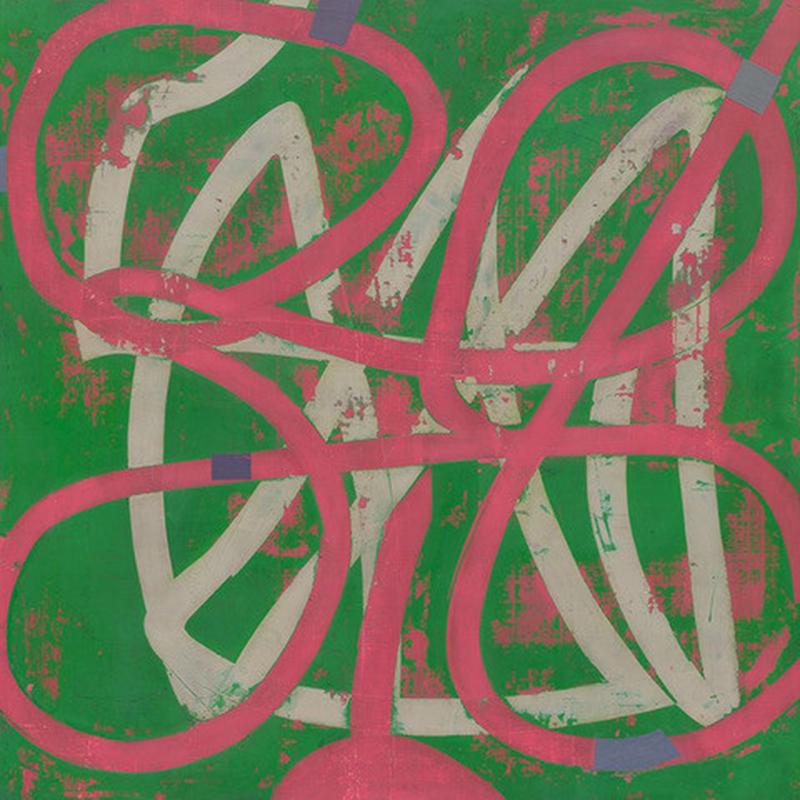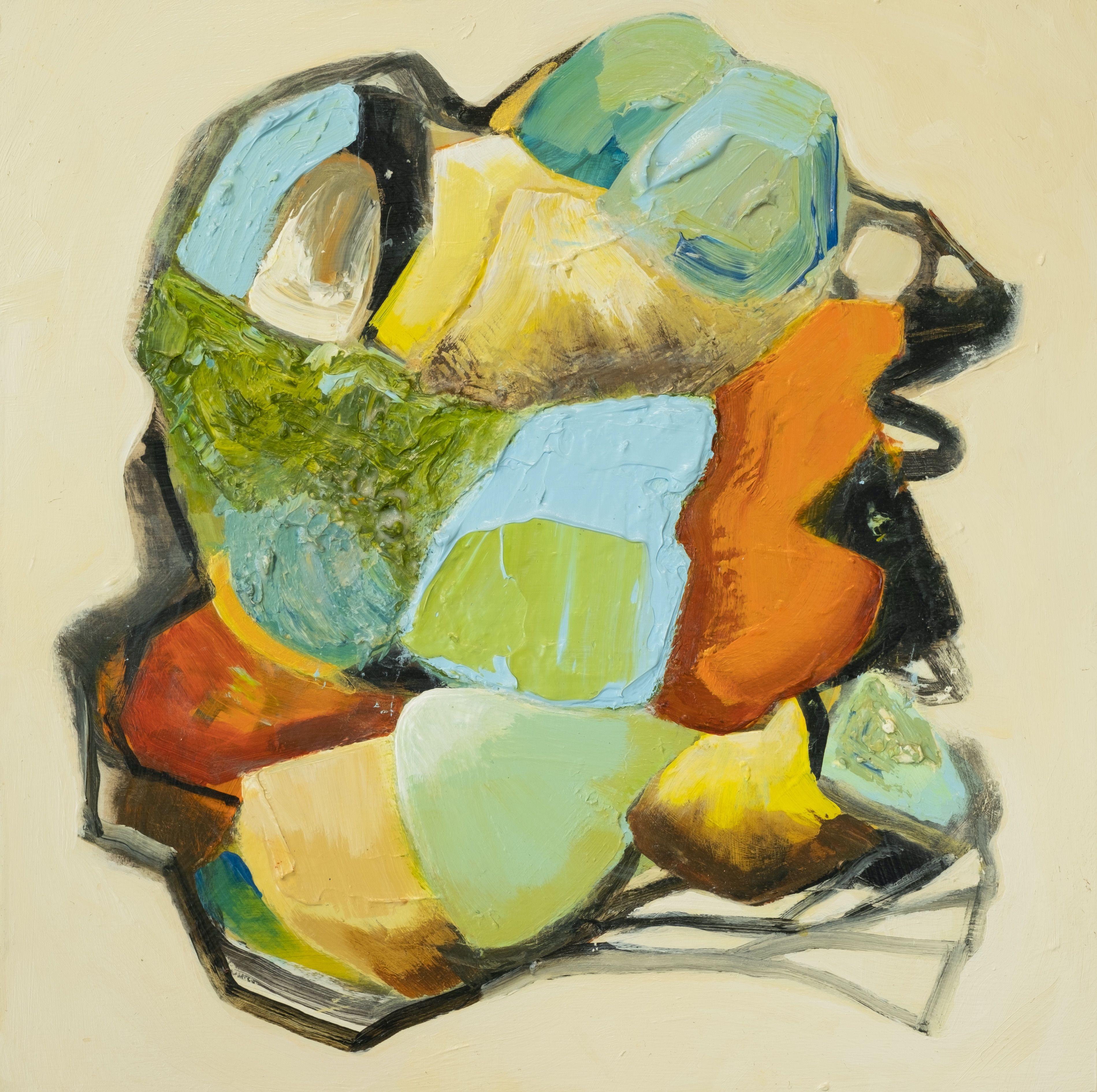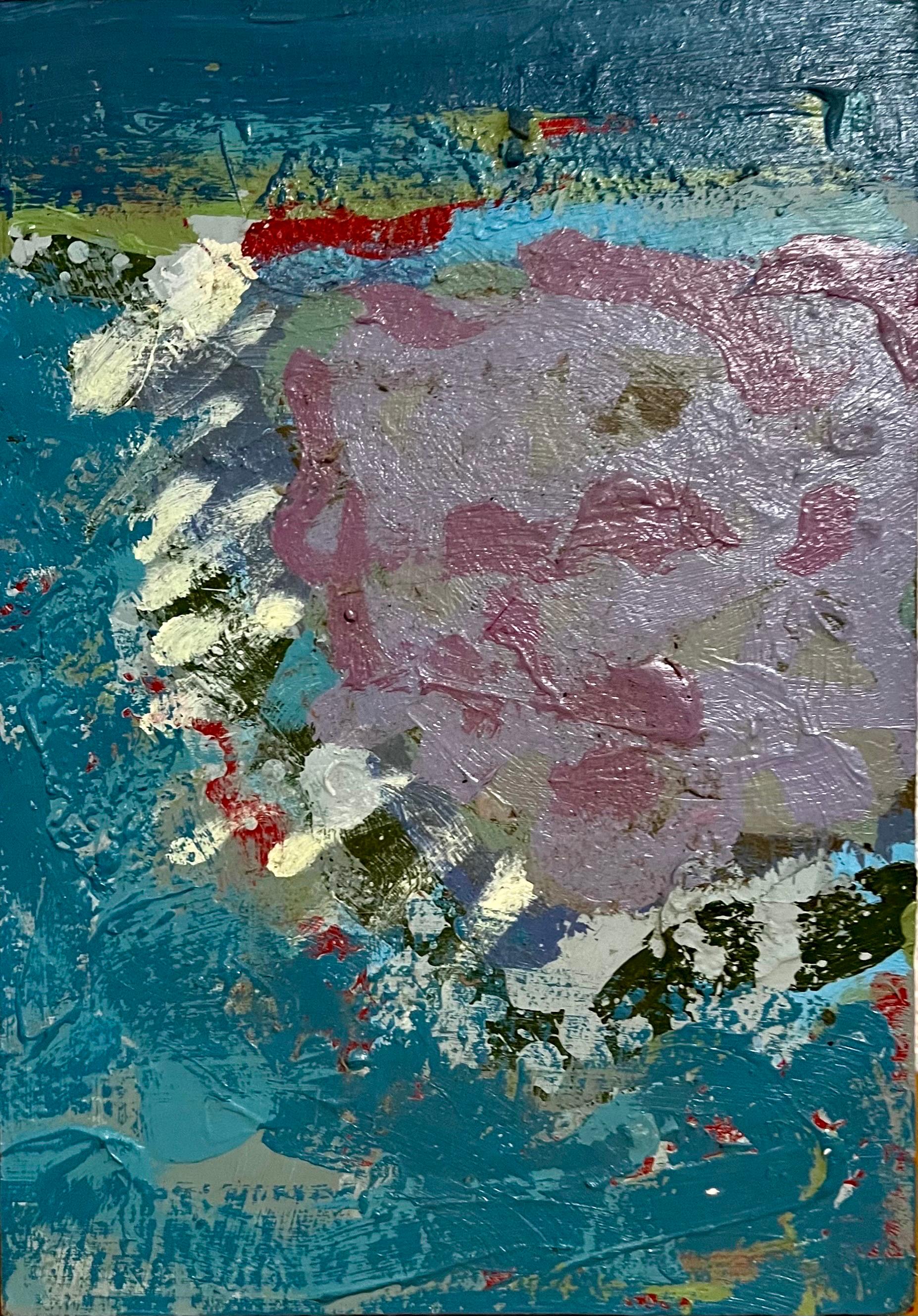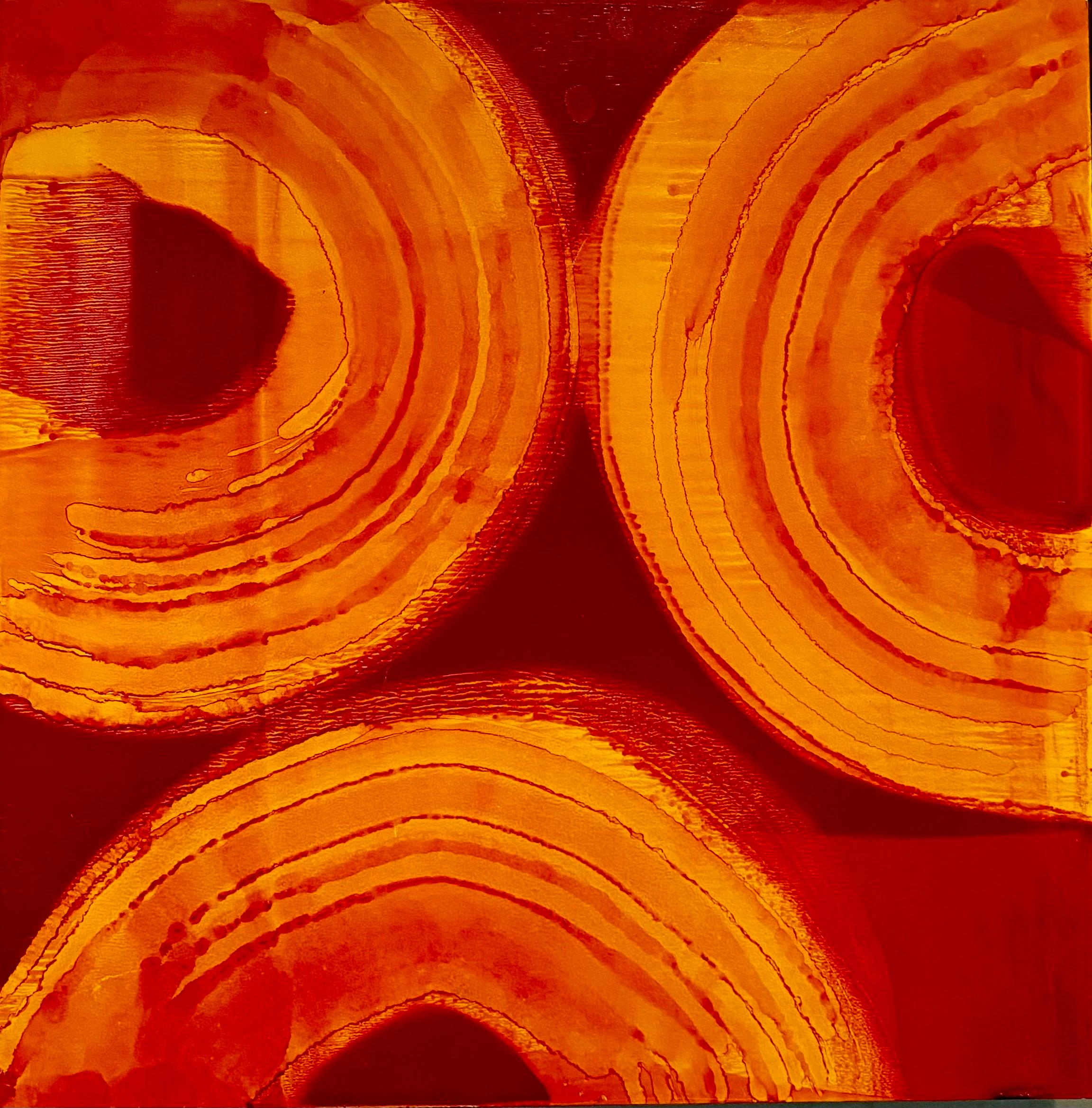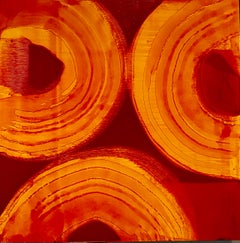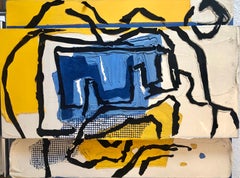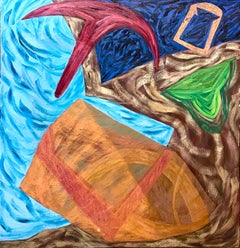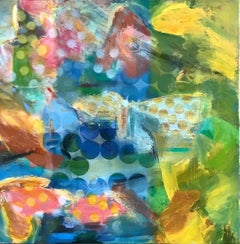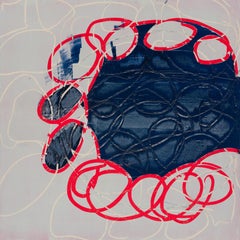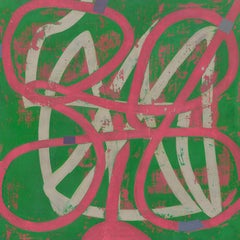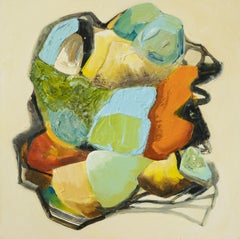Items Similar to "AKEE" Oil Painting, Marylyn Dintenfass Modernist Abstract Expressionist Pop Art
Want more images or videos?
Request additional images or videos from the seller
1 of 10
Marylyn Dintenfass"AKEE" Oil Painting, Marylyn Dintenfass Modernist Abstract Expressionist Pop Art2008
2008
$4,500
£3,397.92
€3,942.28
CA$6,323.91
A$7,045.73
CHF 3,678.21
MX$85,544.58
NOK 46,232.65
SEK 43,701.08
DKK 29,428.66
About the Item
Provenance: Babcock Galleries (bears their label verso.) signed verso with artists monogram signature.
Marylyn Dintenfass (born 1943) is an American painter, printmaker, and sculptor. She is primarily known for her oil paintings, which use a dynamic color palette and lexicon of gestural imagery to explore dualities in the human experience and everyday sensual pleasures.
Marylyn Dintenfass was born in 1943 in Brooklyn, New York and spent most of her early years in Brooklyn and then Long Island. She attended Queens College, and graduated in 1965 with a bachelor's degree in Fine Arts. During this time, the artist worked with Abstract Expressionist painter John Ferren and muralist Barse Miller. Marilyn Dintenfass explored new media and developed her own reaction to abstract expressionism with color, line, and gesture. Dintenfass acquired an appreciation for a broad range of materials that led to major sculpture installations composed of ceramic materials, steel, lead, wood, wax and a variety of pigments and epoxies.
Following a tour of museums in Amsterdam, Paris and Rome, the artist made her way to Jerusalem in 1966. During this journey, the artist worked with painter Ruth Bamberger, studied etching and mingled with the artists and intellectuals of the city. The result was Dintenfass's first architectural commission, to design the “Pop Op Disco,” Jerusalem's first disco. This commission allowed her to work with an array of materials to employ shapes, surfaces, textures, colors, and lights, all of which coalesced in her consciousness that would become important components of her mature personal visual vocabulary. Dintenfass also married and started her family during these years.
Art critic Meredith Mendelsohn writes, “Dintenfass uses luscious colors, repetitive forms, and a gestural intensity that combines Abstract Expressionism and Pop Art.”
Dintenfass often works with oil paint on wooden panels fragmented into parts of a grid. "After completing a painting," writes curator and critic Lilly Wei in a study of Dintenfass' work, "Dintenfass literally takes it apart, treating each panel as a discrete entity, exchanging panels between works in an aesthetic mix and match as she searches for interactions and relationships of color and form that satisfy her sense of visual excitement, sparked by the frisson of the dissonant." In an interview with critic Irving Sandler, Dintenfass speaks of the grid as a necessary, formal restraint for the passion of the gestural marks it contains. Joyce Robinson illuminates; “Dintenfass is at heart, though, a painter, and the grid, with its reference to and notion of modular parts, has remained central to her artistic enterprise, functioning as a kind of Apollonian matrix holding in check the exuberant, vividly colored abstractions of this essentially Dionysian artist.”
Lilly Wei adds, "Ultimately, however, Dintenfass is more sensualist than theorist, and her paintings owe much of their allure to their materiality and the dazzle of color. Her array of ripe, radiant, saturated hues—a palette of gorgeous diversity—can be silkily smooth and nuanced; boldly exuberant; or edgily, feverishly discordant."
The artist's abstract imagery usually appears in her work as various forms of stripes or circles arranged across translucent layers of alternating matte and high gloss textures. In a conversation with gallery owner, John Driscoll, Dintenfass likens these symbols to language that predates the written word, saying her "work relates to communication through the visceral channel." Rooted in autobiography, the artist's paintings also examine the contrast between what she calls the “micro” and the “macro.” At times the shapes simultaneously resemble cells under a microscope and visions of the cosmos. Dintenfass' themes explore the dualities of everyday pleasures; depending on the focus of a series, her symbols might conjure characters, candies, car wheels, or paint itself.
Although known for her paintings, Dintenfass was first recognized for her sculptural installations. Her innovative use of mixed media (ceramics, epoxies, wax, pigments, steel, lead, wood, etc.) transformed understanding of what a “ceramic” work of art could be and firmly fixed her position and influence among a generation of mixed media artists expanding the traditional definitions and boundaries of object and materials to create modern art. The results came as architectural reliefs and installation sculpture unique to her organic but structural personal style. Similar to her paintings, Dintenfass developed a modular language of symbols, amalgams of line and curve, which she would combine to create detailed pictographic languages all her own, what she has called “organic alphabets.” As Ted Castle relates, “Ideas are furtive elements, stolen from the matrix, so as to be reformed by human genius into something unforeseen—a poem, a painting, a game of dominoes, a television set, a brick, a tile, a cup. Marylyn Dintenfass is a master of the transformation of ideas into palpable form.”
Dintenfass has also been commissioned to create many large-scale installations, including works for the State of Connecticut Superior Courthouse; the Port Authority of NY 42nd Street Bus Terminal; IBM in Atlanta, Charlotte, and San Jose; The Baltimore Federal Financial Building; Ben Gurion University, Israel; Tagimi Middle School, Japan; and her 2010 project (and largest project to date) in Ft Myers, Florida entitled “Parallel Park.”
"Parallel Park" is a site-specific artwork for the exterior walls of the Lee County Justice Center's Parking Garage encompassing 30,000 square feet (2,800 m2). Dintenfass's images were enlarged to 10 times their original size employing specialized digitizing software resulting in 23 images, each 33 feet (10 m) high x 23 feet (7.0 m) wide and commercially printed with archival ink on Kevlar fabric and installed on all four facades of the parking structure. Each panel transforms the perimeter of the structure, creating a progression of changing images and colorful patterns, all of which are key elements represented in Dintenfass's paintings and drawings. These images and patterns recall architectural friezes, mosaics, and frescoes of the ancient, medieval and Renaissance artists as well as works by early modern artists such as the Synchromists and the Italian Futurists.
Dintenfass’ work has been included in more than 60 national and international exhibitions and more than a dozen solo shows including the Queens Museum of Art the Katonah Museum, The Greenville County Museum of Art and, at the Mississippi Museum of Art –an exhibition underwritten by the Andy Warhol Foundation. In 2008, her work was included in the inaugural exhibition of the Museum of Arts and Design in New York.
More than 30 public collections hold works by Dintenfass, including the Museum of Fine Arts Houston, Minneapolis Institute of Arts, the Cleveland Museum, The Detroit Institute of Arts, the Smithsonian American Art Museum, and the Metropolitan Museum of Art in New York City.
Dintenfass has twice been a MacDowell Fellow, was awarded a New York Foundation for the Arts Individual Artists Grant, and two National Endowment Project Grants. She was awarded the Silver Medal at the First International Exhibition, Mino, Japan, and the Ravenna Prize at the 45th Concorso Internazionale Della Ceramica D’Arte, Faenza, Italy. She was also a member of the faculty at Parsons School of Design in New York City for ten years. She is included in the recent book 100 New York Painters by Cynthia Maris Dantzig (Schiffer, 2006) and is the subject of Lilly Wei's recently published monograph Marylyn Dintenfass Paintings from Hudson Hills Press.
This artist has earned many honors in the art world. In 1983, Dintenfass garnered the Outstanding Achievement Award, Women in Design International Exhibition in San Francisco, CA. In Mino, Japan she was given the 1986 Silver Medal in the First International Exhibition. More recently in 2002-2003, she became a trustee at the Museum of Ceramic Art in New York City. In addition to these honor, Dintenfass has been a MacDowell fellow and a New York Foundation for the Arts Individual Artist Fellow. The National Endowment for the Arts also gave her two project grants. Dintenfass has also become involved in academia. She was a visiting professor at the National College of Art and Design in Norway, Bezalel Academy of Art and Design in Israel, Sheridan College in Canada, as well as Hunter College in New York city. Additionally, Dintenfass held a faculty position at Parsons School of Design (New York City) where she worked for 10 years.
- Creator:Marylyn Dintenfass (1943, American)
- Creation Year:2008
- Dimensions:Height: 12 in (30.48 cm)Width: 12 in (30.48 cm)Depth: 2 in (5.08 cm)
- Medium:
- Movement & Style:
- Period:
- Condition:good. minor wear.
- Gallery Location:Surfside, FL
- Reference Number:1stDibs: LU38215596282
About the Seller
4.9
Platinum Seller
Premium sellers with a 4.7+ rating and 24-hour response times
Established in 1995
1stDibs seller since 2014
1,798 sales on 1stDibs
Typical response time: <1 hour
- ShippingRetrieving quote...Shipping from: Surfside, FL
- Return Policy
Authenticity Guarantee
In the unlikely event there’s an issue with an item’s authenticity, contact us within 1 year for a full refund. DetailsMoney-Back Guarantee
If your item is not as described, is damaged in transit, or does not arrive, contact us within 7 days for a full refund. Details24-Hour Cancellation
You have a 24-hour grace period in which to reconsider your purchase, with no questions asked.Vetted Professional Sellers
Our world-class sellers must adhere to strict standards for service and quality, maintaining the integrity of our listings.Price-Match Guarantee
If you find that a seller listed the same item for a lower price elsewhere, we’ll match it.Trusted Global Delivery
Our best-in-class carrier network provides specialized shipping options worldwide, including custom delivery.More From This Seller
View AllMod Abstract Expressionist Modernist Oil Painting Edward Avedisian Color Circles
By Edward Avedisian
Located in Surfside, FL
Edward Avedisian ( 1936-2007 )
12 X 8.5
Oil paint on wood panel
This is not signed on front. It bears his name verso.
Provenance: Hudson, N.Y. estate of noted Art Collector Albert B...
Category
1960s Abstract Expressionist Landscape Paintings
Materials
Oil, Wood Panel
Abstract Red Persimmon Oil Painting on Panel Marylyn Dintenfass Modernist
By Marylyn Dintenfass
Located in Surfside, FL
Provenance: Babcock Galleries (bears their label verso. signed verso with artists monogram signature.
Marylyn Dintenfass (born 1943) is an American painter, printmaker, and sculptor. She is primarily known for her oil paintings, which use a dynamic color palette and lexicon of gestural imagery to explore dualities in the human experience and everyday sensual pleasures.
Marylyn Dintenfass was born in 1943 in Brooklyn, New York and spent most of her early years in Brooklyn and then Long Island. She attended Queens College, and graduated in 1965 with a bachelor's degree in Fine Arts. During this time, the artist worked with Abstract Expressionist painter John Ferren and muralist Barse Miller. Marilyn Dintenfass explored new media and developed her own reaction to abstract expressionism with color, line, and gesture. Dintenfass acquired an appreciation for a broad range of materials that led to major sculpture installations composed of ceramic materials, steel, lead, wood, wax and a variety of pigments and epoxies.
Following a tour of museums in Amsterdam, Paris and Rome, the artist made her way to Jerusalem in 1966. During this journey, the artist worked with painter Ruth Bamberger, studied etching and mingled with the artists and intellectuals of the city. The result was Dintenfass's first architectural commission, to design the “Pop Op Disco,” Jerusalem's first disco. This commission allowed her to work with an array of materials to employ shapes, surfaces, textures, colors, and lights, all of which coalesced in her consciousness that would become important components of her mature personal visual vocabulary. Dintenfass also married and started her family during these years.
Art critic Meredith Mendelsohn writes, “Dintenfass uses luscious colors, repetitive forms, and a gestural intensity that combines Abstract Expressionism and Pop Art.”
Dintenfass often works with oil paint on wooden panels fragmented into parts of a grid. "After completing a painting," writes curator and critic Lilly Wei in a study of Dintenfass' work, "Dintenfass literally takes it apart, treating each panel as a discrete entity, exchanging panels between works in an aesthetic mix and match as she searches for interactions and relationships of color and form that satisfy her sense of visual excitement, sparked by the frisson of the dissonant." In an interview with critic Irving Sandler, Dintenfass speaks of the grid as a necessary, formal restraint for the passion of the gestural marks it contains. Joyce Robinson illuminates; “Dintenfass is at heart, though, a painter, and the grid, with its reference to and notion of modular parts, has remained central to her artistic enterprise, functioning as a kind of Apollonian matrix holding in check the exuberant, vividly colored abstractions of this essentially Dionysian artist.”
Lilly Wei adds, "Ultimately, however, Dintenfass is more sensualist than theorist, and her paintings owe much of their allure to their materiality and the dazzle of color. Her array of ripe, radiant, saturated hues—a palette of gorgeous diversity—can be silkily smooth and nuanced; boldly exuberant; or edgily, feverishly discordant."
The artist's abstract imagery usually appears in her work as various forms of stripes or circles arranged across translucent layers of alternating matte and high gloss textures. In a conversation with gallery owner, John Driscoll, Dintenfass likens these symbols to language that predates the written word, saying her "work relates to communication through the visceral channel." Rooted in autobiography, the artist's paintings also examine the contrast between what she calls the “micro” and the “macro.” At times the shapes simultaneously resemble cells under a microscope and visions of the cosmos. Dintenfass' themes explore the dualities of everyday pleasures; depending on the focus of a series, her symbols might conjure characters, candies, car wheels, or paint itself.
Although known for her paintings, Dintenfass was first recognized for her sculptural installations. Her innovative use of mixed media (ceramics, epoxies, wax, pigments, steel, lead, wood, etc.) transformed understanding of what a “ceramic” work of art could be and firmly fixed her position and influence among a generation of mixed media artists expanding the traditional definitions and boundaries of object and materials to create modern art. The results came as architectural reliefs and installation sculpture unique to her organic but structural personal style. Similar to her paintings, Dintenfass developed a modular language of symbols, amalgams of line and curve, which she would combine to create detailed pictographic languages all her own, what she has called “organic alphabets.” As Ted Castle relates, “Ideas are furtive elements, stolen from the matrix, so as to be reformed by human genius into something unforeseen—a poem, a painting, a game of dominoes, a television set, a brick, a tile, a cup. Marylyn Dintenfass is a master of the transformation of ideas into palpable form.”
Dintenfass has also been commissioned to create many large-scale installations, including works for the State of Connecticut Superior Courthouse; the Port Authority of NY 42nd Street Bus Terminal; IBM in Atlanta, Charlotte, and San Jose; The Baltimore Federal...
Category
Early 2000s Abstract Abstract Paintings
Materials
Oil, Panel
Judy Rifka, Abstract Expressionist Oil Painting MIxed Media 3D Construction
By Judy Rifka
Located in Surfside, FL
Hand signed verso, mixed media on two sections of joined canvas
Work is titled "Ego Wall with Mess," circa 1983. Provenance: Brooke Alexander Gallery, New York, New York. bearing their label verso.
24 x 30 x 3-3/4 inches (61.0 x 76.2 x 9.5 cm) Hand signed on the reverse: Judy Rifka
Judy Rifka (born 1945) is an American woman artist active since the 1970s as a painter and video artist. She works heavily in New York City's Tribeca and Lower East Side and has associated with movements coming out of the area in the 1970s and 1980s such as Colab and the East Village, Manhattan art scene. A video artist, book artist and abstract painter, Rifka is a multi-faceted artist who has worked in a variety of media in addition to her painting and printmaking. She was born in 1945 in New York City and studied art at Hunter College, the New York Studio School and the Skowhegan School of Painting and Sculpture in Maine.
Rifka took part in the 1980 Times Square Show, (Organized by Collaborative Projects, Inc. in 1980 at what was once a massage parlor, with now-famous participants such as Jenny Holzer, Nan Goldin, Keith Haring, Kenny Scharf, Jean-Michel Basquiat, and Kiki Smith, the roster of the exhibition reads like a who’s who of the art world), two Whitney Museum Biennials (1975, 1983), Documenta 7, Just Another Asshole (1981), curated by Carlo McCormick and received the cover of Art in America in 1984 for her series, "Architecture," which employed the three-dimensional stretchers that she adopted in exhibitions dating to 1982; in a 1985 review in the New York Times, Vivien Raynor noted Rifka's shift to large paintings of the female nude, which also employed the three-dimensional stretchers. In a 1985 episode of Miami Vice, Bianca Jagger played a character attacked in front of Rifka's three-dimensional nude still-life, "Bacchanaal", which was on display at the Museum of Art Fort Lauderdale. Rene Ricard wrote about Rifka in his influential December 1987 Art Forum article about the iconic identity of artists from Van Gogh to Jean-Michel Basquiat and Keith Haring, The Radiant Child.The untitled acrylic painting on plywood, in the collection of the Honolulu Museum of Art, demonstrates the artist's use of plywood as a substrate for painting. Artist and writer Mark Bloch called her work "imaginative surfaces that support experimental laboratories for interferences in sensuous pigment." According to artist and curator Greg de la Haba, Judy Rifka's irregular polygons on plywood "are among the most important paintings of the decade".
In 2013, Rifka's daily posts on Facebook garnered a large social media audience for her imaginative "selfies," erudite friendly comments, and widely attended solo and group exhibitions, Judy Rifka's pop art figuration is noted for its nervous line and frenetic pace. In the January 1998 issue of Art in America, Vincent Carducci echoed Masheck, “Rifka reworks the neo-classical and the pop, setting all sources in quotation for today’s art-world cognoscenti.” Rifka, along with artists like David Wojnarowicz, helped to take Pop sensibility into a milieu that incorporated politics and high art into Postmodernism; Robert Pincus-Witten stated in his 1988 essay, Corinthian Crackerjacks & Passing Go that "Rifka’s commitment to process and discovery, doctrine with Abstract Expressionist practice, is of paramount concern though there is nothing dogmatic or pious about Rifka’s use of method. Playful rapidity and delight in discovery is everywhere evident in her painting." In 2016, a large retrospective of Rifka's art was shown at the Jean-Paul Najar Foundation in Dubai. In 2017, Gregory de la Haba presented a Rifka retrospective at the Amstel Gallery...
Category
1980s Pop Art Abstract Paintings
Materials
Linen, Oil
Large Colorful 1980s New York Abstract Expressionist Oil Painting Joan Thorne
By Joan Thorne
Located in Surfside, FL
This is a large colorful, bold, vibrant original oil painting on canvas, hand signed and dated 1989.
It is titled Tango.
Joan Thorne (1943-) is a New York artist nationally and internationally recognized. A third generation Abstract Expressionist woman artist who has exhibited works over the past 30 years. Her art has been shown in the Corcoran Gallery of Art, Washington, DC, the Whitney Museum’s Annual Exhibition, the Grand Palais in Paris, and Barbara Rose’s seminal exhibition American Painting: The Eighties at New York University’s Grey Gallery.
Her recent shows in New York City have been reviewed by the New York Times, Art in America, ArtNews and The New Criterion among others. Her work has been compared to Elizabeth Murray work. It is colorful and has a 1980's, Memphis Milano feel to it.
Thorne grew up in Greenwich Village. Her mother was a Ukrainian immigrant from a musical family, who became an English teacher; her father, a surgeon. Recognizing their daughter’s artistic talents early, they enrolled her at age six in the Little Red Schoolhouse on Bleecker Street in Greenwich Village. Founded in 1921 by Elisabeth Irwin, a pioneer in educational reform, the school has continued to maintain its reputation as a progressive and nurturing catalyst for creative children. Pete Seeger, the folk singer, performed there so frequently that Thorne remembered him as if he were one of the teachers. In 1971, Thorne met Faith Ringgold (b. 1930) and joined her as a teacher at the Women’s House of Detention on Rikers Island in a new program called “Art without Walls–Free Space.” The program, which had been born from the civil rights movement, was aimed at enriching the lives of the inmates. Thorne and her peers came of age struggling against sexism in the art establishment and its attendant lack of exhibition opportunities for women. Since 1985, this issue had been loudly exposed by the public protests of the Guerrilla Girls, whose members remain a well-kept secret.
Her painting has been included in two Whitney Museum Biennials and various other museum group exhibitions both in the United States, Europe and Latin America.
She has had numerous one person shows in galleries such as: Sideshow Gallery New York, Fischbach Gallery, New York City, Corcoran Gallery of Art, Washington D.C., Willard Gallery, New York, Graham & Sons Gallery, New York, The Clocktower, New York City, and the National Arts Club among others.
Thorne has been awarded the Prix de Rome Fellowship to paint at the American Academy in Rome. She also received two National Endowment grants for painting and two Pollock Krasner Grants among others.
"Since 1973, while myriad styles, movements and mediums have flourished briefly in turn, Joan Thorne has steadfastly developed one visual language-that of painterly surface, light, color and distilled form-which she finds best suited for her artistic project: intimating dreams. intuitions and the psychic consequences of travel. "
"For there is something luxuriant and mysterious in Thorne's compositions. They have a classic modernist genealogy that encompasses Arthur Dove, Georgia O'Keeffe, Marsden Hartley, Milton Avery and Mark Tobey; yet each carries a hint of exoticism, "
--Richard Vine, Art In America, Review, June 1998
Education
Hunter College, New York, M.A.
New York University, New York, B.S.
Awards
2006 Adolf Gottlieb Foundation Grant in Painting
2003 Prize in Painting, Florence BiennaleInternazionale, Florence, Italy
2001 Pollock Krasner Foundation Grant in Painting
1986 Prix de Rome, American Academy in Rome
Pollock Krasner Foundation Grant in Painting
1983 National Endowment for the Arts, Fellowship in Painting
1980 New York State Council on the Arts, Grant for Painting
1979 National Endowment for the Arts, Fellowship in Painting
1976 Grant in Painting, Rhode Island State Council on the Arts
1975 New York State Council on the Arts, Grant for Painting
1974 Grant in Painting, Rhode Island State Council on the Arts
1972 Artist of the Year, Aldrich Foundation
Select Solo Exhibitions
2015 Black and White Into Color, National Arts Club, New York
2013 Sideshow Gallery, Williamsburg, NY
2005 Chris Winfield Gallery, Carmel, CA
2004 Klaus Steinmetz Arte Contemporaneo, San Rafael de Escazu, Costa Rica
2002 Feria de Arte International Arcale, Salamanca, España
2001 Andre Zarre Gallery, New York
2000 Retrospective: Museo Las Americas, San Juan, Puerto Rico
1998 A Retrospective: Museo Voluntariado De Las Casas Reales, Casa de Bastidas,
Santo Domingo, Dominican Republic
1990 1985 Graham Modern , New York City, NY
1989 1986 Ruth Bachofen Gallery, Santa Monica, CA
1986 William Halsey Gallery, Simon Center for the Arts, College of Charleston, Charleston, SC
1983 Lincoln Center Gallery, Lincoln Center, New York City, NY
Dart Gallery, Chicago, IL
Gloria Luria Gallery, Bay Harbor Island, FL
1982 Nina Freudenheim Gallery, Buffalo, N
1980 Willard Gallery, New York
1979 The Clocktower: Institute for Art and Urban Resources, New York City, NY
1977 Galerie Veith Turske, Cologne Art Fair, Cologne, Germany
1974 Fischbach Gallery, New York City, NY
1973 Corcoran Gallery of Art, Washington, DC
Select Group Exhibitions
2019 Art On Paper, March 2019, New York, NY
2018 Sideshow Gallery, The Greatest Show On Earth, Williamsburg, NY
2015 Outside The Lines/Modernist Drawings, National Arts Club, NY
2014 "National Arbor Day Show", National Arts Club, New York, NY
ArtHamptons Fair, July 10-13, East Hampton, NY
Tribal and Contemporary Art, June 12 - July 28, New York, NY
2012 Art Southampton, International and Contemporary Modern Art Fair, Hollis Taggart
2010 Janet Kurnatowsky Gallery, New York
2003 Biennale Internazionale Dell' Arte Contemporanea, Florence, Italy
2002 Gallery Uno 'Spazio Su Misura, Milan, Italy
1991 Andre Emmerich Gallery, "Abstract Painting of the 90's", curated by Barbara Rose.
New York Stock Exchange, Invitational
1989 Graham Modern, "Synthesis"
1986 Graham Modern, "Diptychs, Triptychs, Polyptychs"
Sidney Janis Gallery, "American Women Artists", New York City, NY
Nina Freudenheim Gallery, Buffalo, NY
N.Y.C.W.C.A., "Abstract Painting: Painting by Women Artists...
Category
1980s Post-Modern Abstract Paintings
Materials
Canvas, Acrylic Polymer, Oil
Modernist American Abstract Expressionist Pop Art Painting on Canvas James Yohe
By James Yohe
Located in Surfside, FL
James Yohe
A Quiet Situation-Move
Acrylic on canvas, 1980,
Hand signed 'Yohe', titled and dated on the reverse, with label from Alexander Milliken Gallery NY.
18 1/2 x 20 1/2 in., t...
Category
1980s Post-Modern Abstract Paintings
Materials
Canvas, Acrylic
Mod Abstract Expressionist Modernist Oil Painting Edward Avedisian Color Circles
By Edward Avedisian
Located in Surfside, FL
Edward Avedisian ( 1936-2007 )
17.5 X 8.75
Oil paint on wood panel
This is not signed on front. It bears his name verso.
Provenance: Hudson, N.Y. estate of noted Art Collector Alber...
Category
1960s Abstract Expressionist Landscape Paintings
Materials
Oil, Wood Panel
You May Also Like
Madeline. Contemporary Abstract Oil Painting
By Peter Rossiter
Located in Brecon, Powys
Contemporary abstract painting by Welsh artist Peter Rossiter.
Artists comments on the painting
"The painting is an exploration of warm relationships between colours and choreograph...
Category
2010s Abstract Abstract Paintings
Materials
Oil
Mary Didoardo "Wild Thing" Oil on Wood Panel Abstract Painting
By Mary Didoardo
Located in New York, NY
Mary Didoardo is a long-time resident of Long Island City, NY. She was born in New Jersey and has lived in New York City since graduating from Pratt Institute where she studied sculp...
Category
2010s Abstract Paintings
Materials
Oil, Wood Panel
Mary Didoardo "Gong" Abstract Oil Painting on Wood Panel
By Mary Didoardo
Located in New York, NY
Mary Didoardo
Gong, 2020
oil on wood panel
30 x 30 in.
(dido076)
This original abstract oil painting on wood by Mary Didoardo features her signature layering technique and looping l...
Category
2010s Abstract Abstract Paintings
Materials
Oil, Wood Panel
383 Hidden Gems l, Painting, Acrylic on Wood Panel
By Anne B Schwartz
Located in Yardley, PA
These paintings on cradled wood panels all have a spontaneous, uninhibited quality. There is plenty of unusual color combinations, interesting shapes, and lots of texture. The painti...
Category
2010s Abstract Abstract Paintings
Materials
Acrylic
384 Hidden Gems ll, Painting, Acrylic on Wood Panel
By Anne B Schwartz
Located in Yardley, PA
These paintings on cradled wood panels all have a spontaneous, uninhibited quality. There is plenty of unusual color combinations, interesting shapes, and lots of texture. The painti...
Category
2010s Abstract Abstract Paintings
Materials
Acrylic
Conceptual, Catherine Pennington-Meyer, Original Abstract Painting, Affordable
By Catherine Pennington-Meyer
Located in Deddington, GB
Conceptual [2021]
original
Acrylic on canvas
Image size: H:100 cm x W:100 cm
Complete Size of Unframed Work: H:100 cm x W:100 cm x D:4cm
Sold Unframed
Please note that insitu im...
Category
21st Century and Contemporary Abstract Abstract Paintings
Materials
Canvas, Acrylic
More Ways To Browse
Structural Art
Medieval Italian Art
Bear Pop Art
Pop Art Ceramic
Set Of Four Oil Paintings
Italian Ceramics Abstract
Abstract Japanese Ceramics
Medieval Panel
Micro Mosaic Art
Ben Long
Irving Oil
Ancient Brick
Frieze Drawing
Oil Paintings Mississippi
Fresco Panel
Abstract Ceramic Tile
Brick Building Painting
Joyce Oil
